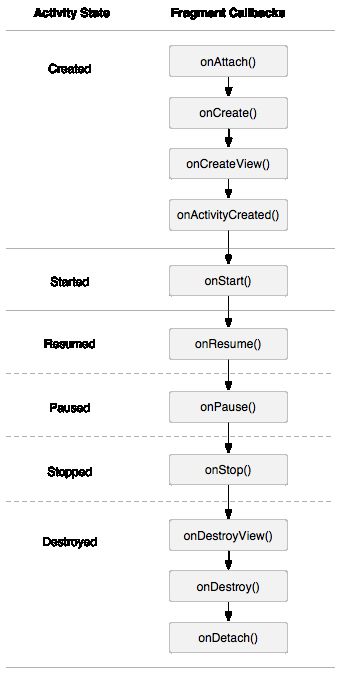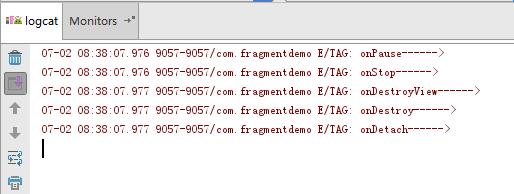Android 3.0中引入fragments 的概念,其目的是为了解决不同屏幕分辩率的动态和灵活UI设计,它是通过将Activity 的布局分散到frament 中,依托于activity而存在,frament 的生命周期会直接受到activity生命周期的影响,谷歌官网的这张生命周期关系图就说明这些;
同时frament 还多了些Activity 没有的生命周期,下面看下frament 的生命周期是如何调用的;
加载该frament 的时候:
切换frament 的时候:
这里采用的是add和replace的方式添加fragment和切换的,在加载的时候首先调用的是onAttach();
onAttach()
/**
* Called when a fragment is first attached to its context.
* {@link #onCreate(Bundle)} will be called after this.
*/
@CallSuper
public void onAttach(Context context) {
mCalled = true;
final Activity hostActivity = mHost == null ? null : mHost.getActivity();
if (hostActivity != null) {
mCalled = false;
onAttach(hostActivity);
}
}
onAttach源码和注释中看到当fragment 第一次被依附于它的上下文的时候会被调用,同时onCreate会在它的后面调用,同时它是通过FragmentHostCallBack中的
Activity getActivity() {
return mActivity;
}
获取到该activity,如果该activity不是空的,就绑定在该activity上面,
onCreate()
/**
* Called to do initial creation of a fragment. This is called after
* {@link #onAttach(Activity)} and before
* {@link #onCreateView(LayoutInflater, ViewGroup, Bundle)}.
*/
@CallSuper
public void onCreate(@Nullable Bundle savedInstanceState) {
mCalled = true;
restoreChildFragmentState(savedInstanceState);
if (mChildFragmentManager != null
&& !mChildFragmentManager.isStateAtLeast(Fragment.CREATED)) {
mChildFragmentManager.dispatchCreate();
}
}
从注释中看到onCreate方法是调用来创建片段的初始创建,在onAttach之后onCreateView之前调用,
onCreateView()
/**
* Called to have the fragment instantiate its user interface view.
*/
@Nullable
public View onCreateView(LayoutInflater inflater, @Nullable ViewGroup container,
@Nullable Bundle savedInstanceState) {
return null;
}
fragment实例化自己的视图的时候被调用
onActivityCreate()
/**
* Called when the fragment's activity has been created and this
* fragment's view hierarchy instantiated
*/
@CallSuper
public void onActivityCreated(@Nullable Bundle savedInstanceState) {
mCalled = true;
}
fragment的activity已经被创建同时fragment的视图已经初始化也就是fragment的onCreateView被调用后就会调用onActivityCreate生命周期
onStart()
/**
* Called when the Fragment is visible to the user. This is generally
* tied to {@link Activity#onStart() Activity.onStart} of the containing
* Activity's lifecycle.
*/
@CallSuper
public void onStart() {
}
fragment用户可见的时候调用,通常与activity的onStart联系在一起;
onResume()
/**
* Called when the fragment is visible to the user and actively running.
* This is generally
* tied to {@link Activity#onResume() Activity.onResume} of the containing
* Activity's lifecycle.
*/
@CallSuper
public void onResume() {
mCalled = true;
}
fragment可见于用户,并且已经运行的时候调用,那就肯定是在onStart之后调用了;
从运行的效果图看,以上这些就是fragment加载时会调用的生命周期,
onAttach--->onCreate--->onCreateView--->onActivityCreate--->onStart--->onResume
再来看看fragment的切换时的生命周期,运行的结果为:
onPause--->onStop--->onDestoryView--->onDestory--->onDetach
onPause()
/**
* Called when the Fragment is no longer resumed. This is generally
* tied to {@link Activity#onPause() Activity.onPause} of the containing
* Activity's lifecycle.
*/
@CallSuper
public void onPause() {
mCalled = true;
}
fragment已不resumed了,也就是说用户不可见,并且退出运行的时候会调用;
onStop()
/**
* Called when the Fragment is no longer started. This is generally
* tied to {@link Activity#onStop() Activity.onStop} of the containing
* Activity's lifecycle.
*/
@CallSuper
public void onStop() {
mCalled = true;
}
fragment已不started就会调用该生命周期
onDestoryView()
/**
* Called when the view previously created by {@link #onCreateView} has
* been detached from the fragment. The next time the fragment needs
* to be displayed, a new view will be created. This is called
* after {@link #onStop()} and before {@link #onDestroy()}.
*/
@CallSuper
public void onDestroyView() {
mCalled = true;
}
由onCreateView创建的视图已经从fragment脱离的时候调用,同时下次该fragment显示的时会创建一个新的view,该生命周期在onStop之后onDestory之前调用
onDestory()
/**
* Called when the fragment is no longer in use. This is called
* after {@link #onStop()} and before {@link #onDetach()}.
*/
@CallSuper
public void onDestroy() {
}
fragment不再使用的时候调用,生命周期位于onStop之前onDetach之前
onDetach()
/**
* Called when the fragment is no longer attached to its activity. This
* is called after {@link #onDestroy()}.
*/
@CallSuper
public void onDetach() {
mCalled = true;
}
fragment已经不在依托于activity会调用,生命周期位于onDestory之后;
如上面写的有不对的欢迎交流。


